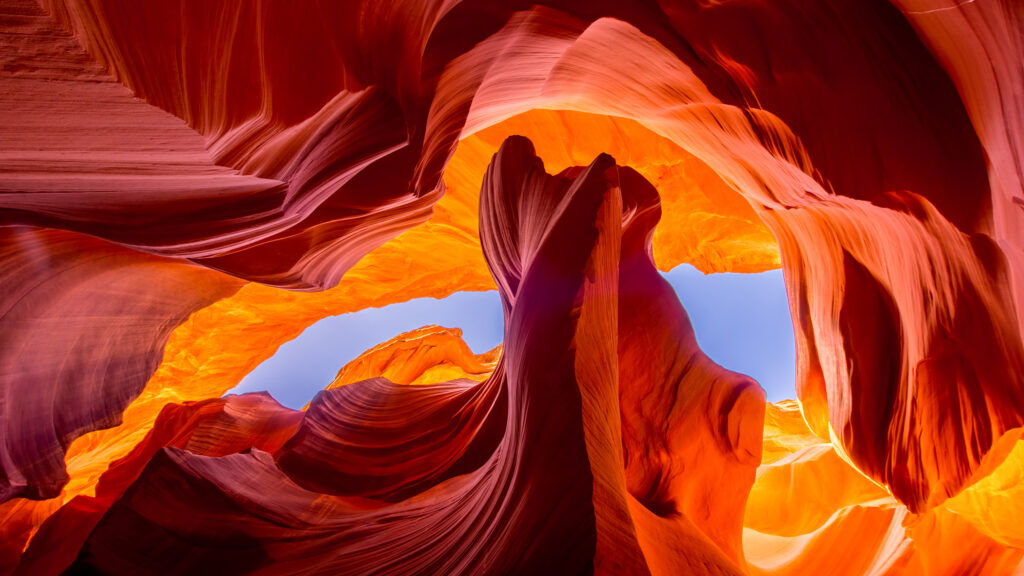Antelope Canyon, nestled in northern Arizona, is a destination that combines natural artistry and cultural heritage. Its wave-like sandstone walls and vibrant light beams captivate photographers and travelers worldwide. This slot canyon, located on Navajo land, represents one of the most iconic and visually striking natural wonders in the American Southwest.
Understanding Antelope Canyon’s Formation
Antelope Canyon’s unique structure is the result of thousands of years of erosion. Water from flash floods carved the sandstone walls, creating the smooth, flowing curves that define the canyon today. The site features two sections: Upper Antelope Canyon, or “The Crack,” and Lower Antelope Canyon, often called “The Corkscrew.”
Upper Antelope Canyon is renowned for its narrow passageways and mesmerizing light beams, especially during the summer months. Visitors are drawn to these light shafts, which seem to spotlight the canyon’s vivid textures and warm hues. Lower Antelope Canyon, on the other hand, offers a more adventurous experience with steeper descents and twisting paths. Both sections provide a unique opportunity to witness nature’s artistic power.
Capturing Perfect Photographs
Photographers often regard Antelope Canyon as a dream destination. The ever-changing interplay of light and shadow creates dynamic visuals that vary by the minute. To make the most of your visit, aim to explore the canyon during mid-morning or early afternoon. This is when sunlight filters through the narrow openings, illuminating the walls with radiant colors.
Using a wide-angle lens helps frame the expansive curves and towering walls effectively. A tripod is also valuable for stabilizing your camera in the canyon’s dim light conditions. For sharper images, set a higher ISO and a wide aperture, allowing you to capture the fine details of the sandstone textures. To further enhance your shots, consider experimenting with different angles, as the canyon’s features reveal new perspectives with every step.

The Importance of Guided Tours
Access to Antelope Canyon is restricted to guided tours, which are led by Navajo operators. These tours are essential for ensuring safety, preserving the canyon’s delicate environment, and honoring Navajo cultural practices. Guides provide valuable insights into the history, geology, and spiritual significance of the canyon, enriching the visitor experience.
Tour options range from general sightseeing to photography-specific tours, allowing visitors to tailor their experience. Booking in advance is highly recommended, especially during peak seasons, as tour slots fill quickly. Additionally, adhere to any restrictions on items like tripods or large bags to maintain group safety and efficiency.
Tips for a Memorable Visit
To fully appreciate Antelope Canyon, proper preparation is key. Wear comfortable shoes suitable for walking on sandy and uneven terrain. Bring a camera with the appropriate settings pre-adjusted to save time during the tour. Since space within the canyon can be tight, keep your belongings minimal and follow all instructions from your guide.
Respect for the environment and local culture is equally important. Stay on designated paths, avoid touching the sandstone walls, and leave no trace of your visit. By doing so, you contribute to preserving the canyon’s pristine beauty for future generations.
Beyond Photography: The Canyon’s Spiritual Connection
Antelope Canyon is more than just a natural wonder; it holds profound cultural and spiritual significance for the Navajo people. Its name in Navajo, “Tse’ bighanilini,” translates to “the place where water runs through rocks.” For the Navajo, the canyon symbolizes the beauty and power of nature, serving as a reminder of their deep connection to the land.
Visitors are encouraged to approach the canyon with respect and mindfulness. The quiet atmosphere within its walls invites reflection, making the experience as spiritual as it is visually stunning.
Conclusion: A Natural Treasure Worth Exploring
Antelope Canyon offers an extraordinary blend of natural beauty and cultural depth. Its sculpted walls, vivid colors, and captivating light beams create an unforgettable experience for all who visit. Whether you are a photographer seeking the perfect shot or a traveler looking to connect with nature, this canyon promises moments of awe and inspiration.
By following preparation tips, respecting Navajo traditions, and embracing the canyon’s unique qualities, you can ensure a visit that is both rewarding and responsible.
